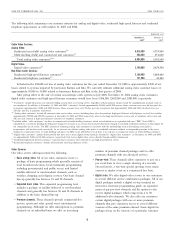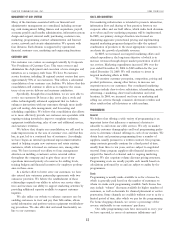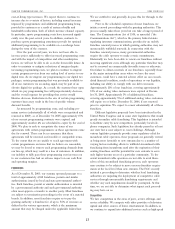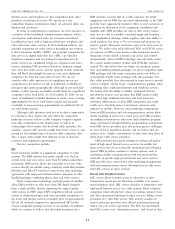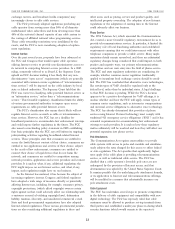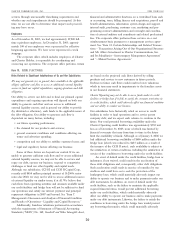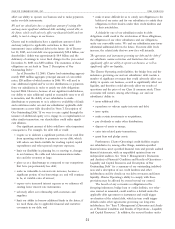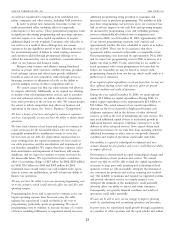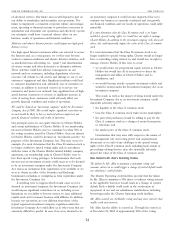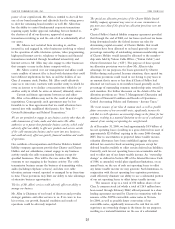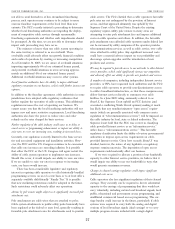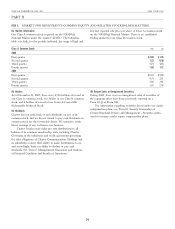Charter 2005 Annual Report Download - page 29
Download and view the complete annual report
Please find page 29 of the 2005 Charter annual report below. You can navigate through the pages in the report by either clicking on the pages listed below, or by using the keyword search tool below to find specific information within the annual report.
CHARTER COMMUNICATIONS, INC. 2005 FORM 10-K
exclusive control) would be unbundled from the basic converter Moreover, the Copyright Office has not yet provided any
functions, which could then be provided by third party vendors. guidance as to the how the compulsory copyright license should
The first phase of implementation has already passed. A apply to newly offered digital broadcast signals.
prohibition on cable operators leasing digital set-top terminals Copyright clearances for non-broadcast programming ser-
that integrate security and basic navigation functions is currently vices are arranged through private negotiations. Cable operators
scheduled to go into effect as of July 1, 2007. Charter is among also must obtain music rights for locally originated program-
the cable operators challenging that provision in court. ming and advertising from the major music performing rights
The FCC has adopted rules implementing an agreement organizations. These licensing fees have been the source of
between major cable operators and manufacturers of consumer litigation in the past, and we cannot predict with certainty
electronics on ‘‘plug and play’’ specifications for one-way digital whether license fee disputes may arise in the future.
televisions. The rules require cable operators to provide ‘‘Cable- Franchise Matters
Card’’ security modules and support to customer owned digital Cable systems generally are operated pursuant to nonexclusive
televisions and similar devices equipped with built-in set-top franchises granted by a municipality or other state or local
terminal functionality. Cable operators must support basic home government entity in order to cross public rights-of-way. Cable
recording rights and copy protection rules for digital program- franchises generally are granted for fixed terms and in many
ming content. The FCC’s plug and play rules are under appeal, cases include monetary penalties for noncompliance and may be
although the appeal has been stayed pending the FCC terminable if the franchisee fails to comply with material
reconsideration. provisions.
The FCC is conducting additional related rulemakings, and The specific terms and conditions of cable franchises vary
the cable and consumer electronics industries are currently materially between jurisdictions. Each franchise generally con-
negotiating an agreement that would establish additional specifi- tains provisions governing cable operations, franchise fees,
cations for two-way digital televisions. Congress is also consider- system construction, maintenance, technical performance, and
ing companion ‘‘broadcast flag’’ legislation to provide copy customer service standards. A number of states subject cable
protection for digital broadcast signals. It is unclear how this systems to the jurisdiction of centralized state government
process will develop and how it will affect our offering of cable agencies, such as public utility commissions. Although local
equipment and our relationship with our customers. franchising authorities have considerable discretion in establish-
Other Communications Act Provisions and FCC Regulatory Matters ing franchise terms, there are certain federal protections. For
In addition to the Communications Act provisions and FCC example, federal law caps local franchise fees and includes
regulations noted above, there are other statutory provisions and renewal procedures designed to protect incumbent franchisees
FCC regulations affecting our business. The Communications from arbitrary denials of renewal. Even if a franchise is renewed,
Act, for example, includes cable-specific privacy obligations. The however, the local franchising authority may seek to impose
Act carefully limits our ability to collect and disclose personal new and more onerous requirements as a condition of renewal.
information. Similarly, if a local franchising authority’s consent is required for
FCC regulations include a variety of additional areas, the purchase or sale of a cable system, the local franchising
including, among other things: (1) equal employment opportu- authority may attempt to impose more burdensome require-
nity obligations; (2) customer service standards; (3) technical ments as a condition for providing its consent.
service standards; (4) mandatory blackouts of certain network, Different legislative proposals have been introduced in the
syndicated and sports programming; (5) restrictions on political United States Congress and in some state legislatures that would
advertising; (6) restrictions on advertising in children’s program- greatly streamline cable franchising. This legislation is intended
ming; (7) restrictions on origination cablecasting; (8) restrictions to facilitate entry by new competitors, particularly local tele-
on carriage of lottery programming; (9) sponsorship identifica- phone companies. Such legislation has already passed in at least
tion obligations; (10) closed captioning of video programming; one state, but is now subject to court challenge. Although
(11) licensing of systems and facilities; (12) maintenance of various legislative proposals provide some regulatory relief for
public files; and (13) emergency alert systems. incumbent cable operators, these proposals are generally viewed
It is possible that Congress or the FCC will expand or as being more favorable to new entrants due to a number of
modify its regulation of cable systems in the future, and we varying factors, including efforts to withhold streamlined cable
cannot predict at this time how that might impact our business. franchising from incumbents until after the expiration of their
For example, there have been recent discussions about imposing existing franchises and the potential for new entrants to serve
‘‘indecency’’ restrictions directly on cable programming. only higher-income areas of a particular community. To the
extent incumbent cable operators are not able to avail them-
Copyright selves of this streamlined franchising process, such operators
Cable systems are subject to federal copyright licensing covering may continue to be subject to more onerous franchise require-
carriage of television and radio broadcast signals. The possible ments at the local level than new entrants. The FCC recently
modification or elimination of this compulsory copyright license is initiated a proceeding to determine whether local franchising
the subject of continuing legislative review and could adversely authorities are impeding the deployment of competitive cable
affect our ability to obtain desired broadcast programming.
19


